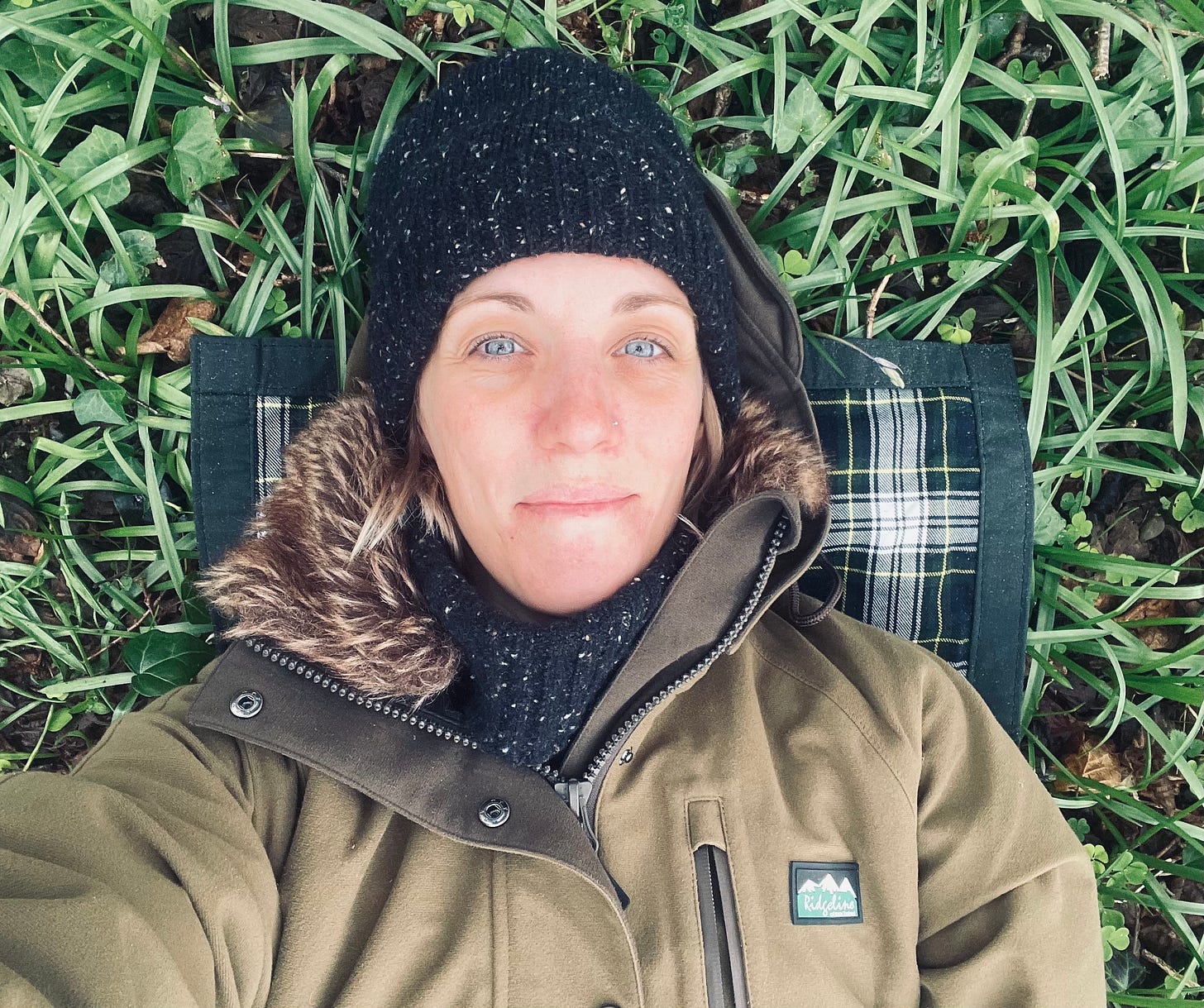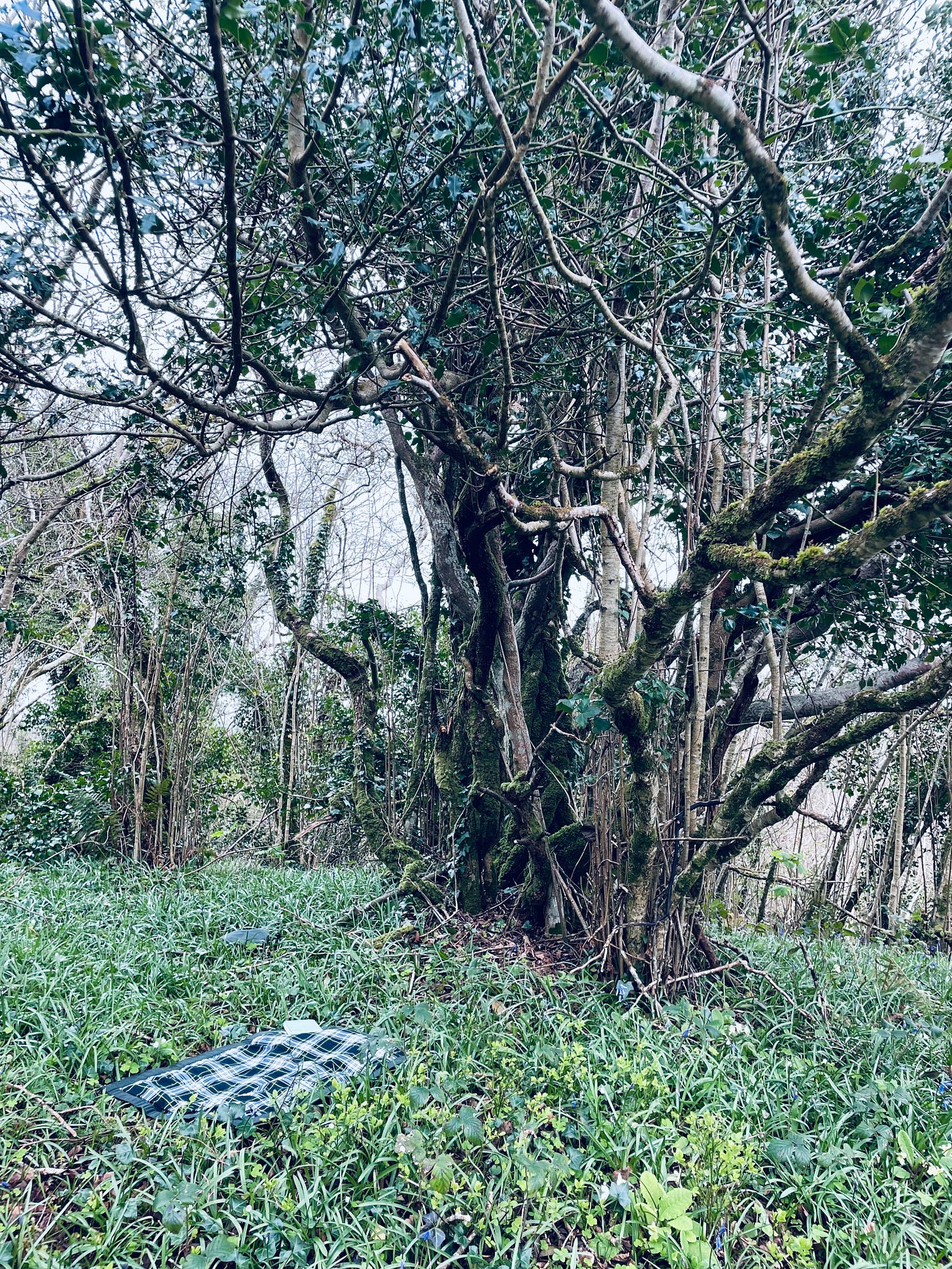I have taken to lying around in forests. It occurred to me that to walk through nature gives me a certain top-down perspective. I step on bluebells, push briars aside, snack on gorse as I’m passing. What if I got down to ground level?
It’s what I was trained to do as a parent: to kneel beside my toddlers, to level the playing field. Then I might see the world through their eyes and better appreciate their struggles.
So, on a mild Thursday morning, you might find me among the lesser celandine at the base of the holly tree on the hill. (You probably wouldn’t find me, to be honest, I lie very still in the hope of being mistaken for a log over which wild animals might step.)
Here’s what I have seen.
The holly tree, from this angle, is loved to death by ivy. The two have grown old together, plaiting their trunks skyward until it is impossible to see who owns what. That, on its own, is beautiful.
But we are in a threshold time, so I pay attention.
At Bealtaine, on the 1st May, we enter the light half of the year. Darkness gives way to light; feminine principles of surrender, nurture, dreaming give way to masculine principles of action, manifestation and execution.
When I look up, I see this shift. Leaves are a bright, new green, clouds of duck fly hover, the bees are loaded with pollen and fly like drunk teenagers hive-ward. There is activity everywhere.
The holly (seen as male by the Celts) and the ivy (female) are stronger than the sum of their parts here. Holly is usually a shrub level tree. This one has grown higher than the surrounding trees, with multiple stems shooting long and lithe toward the light. The ivy has twisted snake-like up these trunks to claim its fair share of canopy. It’s not a competition, it’s an embrace.
Precocious Blackthorn
I am also paying close attention to the hedgerow (aren’t we all?) Blackthorn is in flower, the sharp-thorned tree associated with death and the hag of winter. It is precocious, it flowers before it leafs to ensure better access to pollen and more sloes come autumn.
Blackthorn’s bright sister, hawthorn, is now in leaf. Known as May flower, its white blossoms come after Bealtaine. What beautiful spring symmetry straddling this transition.
Eavan Boland opens her poem White Hawthorn in the West of Ireland like this:
‘I drove West
in the season between seasons.’
She too is compelled to do something at this in between time. She gets in the car, leaves Dublin and comes here, to the west of Ireland with, ‘…the hard shyness of Atlantic light/ and the superstitious aura of hawthorn.’
I love how she describes hawthorn as, ‘…the only language spoken in those parts.’
It is the vernacular I am trying to learn, although I think it is primarily a language of listening, of holding my tongue.
Hedge School
I have become a student of Scoil Scairte, a Hedge School. It is based on outdoor gatherings that formed in Ireland in the 18th and 19th century when education was outlawed for any non-conforming faiths (Catholic and Presbyterian). Locals met under hedges, in ditches and other rural spots to gain rudimentary schooling. It was their response to the threat of losing their culture. This is my attempt to find mine.
Many of my fellow students learned Irish at school, and have a basic grasp of the language. I did not have that option, so I do not.
My nine-week course is focused on the ‘soul of the Irish language’ with guides from the world of storytelling, hip hop, hurling, ecology, folklore and many other creative practices.
When I listen to the talks, which are given sentence by sentence in both English and Irish, the language washes over me in waves. I am told it is my mother tongue, yet I am dancing outside it with no apparent way in.
I am not sure if I will ever be able to hold a conversation with someone from the Gaeltacht, but that is okay, I may never speak Hawthorn either. I see these languages as one way to root myself in this landscape and better understand my place here.
Divine Gifts
Mary Oliver promises me that, ‘Everything in the world comes. At least, closer. And, cordially.’ I have begun to expect it. So, when there is a slight disturbance beside me, I catch the suggestion of wren (she moves too fast to be seen completely) and I investigate. Dreoilín (drow-leen), wren, is a magical little bird associated with divinity.
I too, draw a little closer…
And closer still…
I receive these moments as gifts and there are so many to go around. Throw your rug beneath a tree, listen to its stories, even if you don’t speak the language, your body knows it by heart.
Reteaching
I will leave you with a poem I read at this time of the year. It marries two of my favourite things: poetry and pigs.
We were taught some basic greetings in our class this week. To greet one another is beannacht, blessing. May this poem remind us of our capacity to extend blessing to those around us whether animal, human or flower.
Saint Francis and the Sow
The bud
stands for all things,
even for those things that don’t flower,
for everything flowers, from within, of self-blessing;
though sometimes it is necessary
to reteach a thing its loveliness,
to put a hand on its brow
of the flower
and retell it in words and in touch
it is lovely
until it flowers again from within, of self-blessing;
as Saint Francis
put his hand on the creased forehead
of the sow, and told her in words and in touch
blessings of earth on the sow, and the sow
began remembering all down her thick length,
from the earthen snout all the way
through the fodder and slops to the spiritual curl of the tail,
from the hard spininess spiked out from the spine
down through the great broken heart
to the sheer blue milken dreaminess spurting and shuddering
from the fourteen teats into the fourteen mouths sucking and blowing beneath them:
the long, perfect loveliness of sow.








Lovely - glad I am not the only one who likes to lie down in the woods trying to be mistaken for a log!!! :-)
I love the image of the holly being loved to death by the ivy. Beautiful!